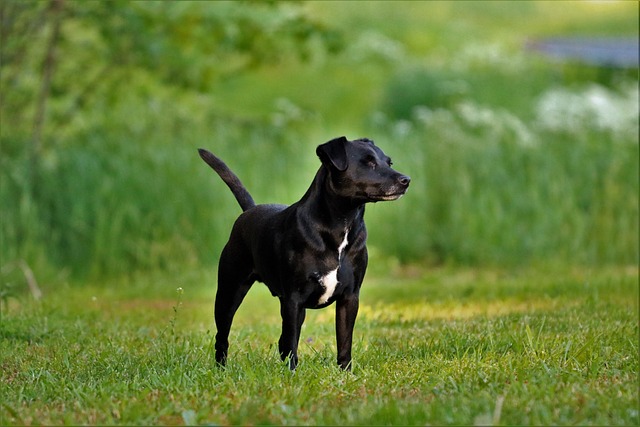


The Patterdale Terrier is a small, rugged, and energetic breed known for its intelligence, agility, and fearlessness. Originally bred for hunting, the Patterdale Terrier is a highly driven dog with strong prey instincts and a tenacious personality. Although small in size, this breed is strong and tough, often displaying an independent nature. Patterdales are typically loyal to their owners and make excellent working dogs, especially for tasks like hunting and rodent control. However, they also make affectionate companions in the right homes, particularly with active families or individuals who can meet their exercise and mental stimulation needs.
The Patterdale Terrier originated in the Lake District of Northern England, where it was bred for hunting purposes, primarily to catch small game like rats, rabbits, and foxes. The breed was developed from a variety of terriers, including the Bedlington Terrier, the Black and Tan Terrier, and the Border Terrier. The Patterdale Terrier was specifically bred to be a hardworking, tenacious, and fearless dog, with the ability to work in difficult terrain and chase prey into dens. Its small size allowed it to access burrows and other tight spaces where larger dogs could not reach. While it was originally a working dog, the Patterdale has gained popularity as a companion animal in recent years, appreciated for its intelligence and determination. It remains a popular choice among hunters and those involved in terrier sports.
The Patterdale Terrier is a small but sturdy dog, typically standing between 10 to 12 inches tall at the shoulder and weighing 11 to 13 pounds. This breed has a muscular, compact body, with a deep chest and a strong, well-proportioned frame. The coat is dense and wiry, providing protection against harsh weather and rough terrain. It comes in a variety of colors, including black, black and tan, chocolate, and red, and may have a slight white marking on the chest or feet. The head is broad with a well-defined stop and a strong jaw, and the ears are small, triangular, and slightly folded forward. The eyes are dark and expressive, often giving the Patterdale Terrier an alert and determined look. Their tail is often carried straight or slightly curved, and it is typically thick and tapered at the end.
The Patterdale Terrier is known for its bold and confident personality. Despite its small size, this breed is incredibly courageous and fearless, often exhibiting a "larger-than-life" attitude. Patterdales are highly intelligent, independent, and determined, which can make them a bit stubborn at times. They are also known for being very loyal and affectionate with their families. While they are generally good with children and other pets if raised together, their strong prey drive means they may not always get along with smaller animals like rabbits or cats. This breed tends to be alert and vocal, making them excellent watchdogs. Their strong independence may sometimes make them challenging to train, but with consistent and positive reinforcement, they can be well-behaved companions.
The Patterdale Terrier is an active and energetic breed that requires regular exercise to stay healthy and happy. While they may be small in size, they have a lot of energy and need daily walks, playtime, and opportunities to engage in stimulating activities. Patterdales enjoy activities like running, hiking, and digging, and they are particularly suited for homes with large yards or access to safe outdoor spaces. They have a strong prey drive and may enjoy chasing small animals, so it's important to provide them with a securely fenced area when outside. This breed also enjoys mental challenges, such as puzzle toys or games that engage their hunting instincts. Without enough physical and mental exercise, a Patterdale Terrier may become bored and display undesirable behaviors, such as excessive barking or digging.
Training a Patterdale Terrier can be a bit challenging due to their independent and sometimes stubborn nature. They are highly intelligent dogs, but they may not always be eager to please, which can make training difficult at times. Positive reinforcement methods, such as using treats, praise, and play, work best with this breed. Short, consistent training sessions that are fun and engaging will help keep their attention. Early socialization is important for Patterdales, as it helps them learn to interact appropriately with other dogs, animals, and people. Exposing them to different environments, sounds, and situations from a young age can help prevent undesirable behaviors, such as excessive fear or aggression. While they can be social and friendly, their strong prey drive means that they may not always get along with other small animals, so proper supervision is necessary.
The Patterdale Terrier is generally a healthy breed, with a lifespan of 12 to 15 years. However, like all breeds, they are susceptible to certain health conditions. Some common health issues in Patterdales include hip dysplasia, patellar luxation (a knee joint issue), and eye problems like progressive retinal atrophy (PRA). Regular veterinary check-ups and screenings can help detect these conditions early. Their dense, wiry coat requires regular grooming to prevent matting and to keep it looking its best. Brushing once or twice a week is typically sufficient, and occasional hand-stripping may be needed to maintain the texture of their coat. Regular ear cleaning, nail trimming, and dental care are also important aspects of maintaining their health. Patterdales are generally low-maintenance in terms of grooming, but their high energy levels require daily exercise and stimulation to stay healthy.
The average lifespan of a Patterdale Terrier is between 12 and 15 years. With proper care, including regular veterinary check-ups, a healthy diet, and sufficient exercise, they can enjoy a long and healthy life. Like all dogs, their lifespan can be influenced by factors such as genetics, environment, and overall health. Patterdales are generally resilient dogs, but regular health screenings and attention to any signs of illness can help ensure that they live a happy and active life.
© copyright Dog Compendium 2024 - 2025